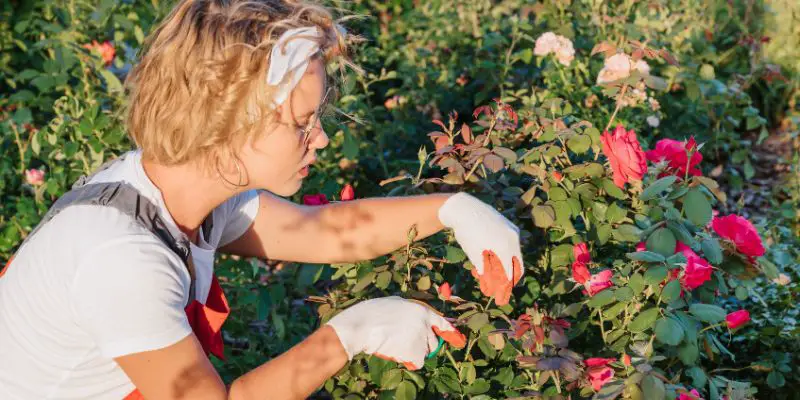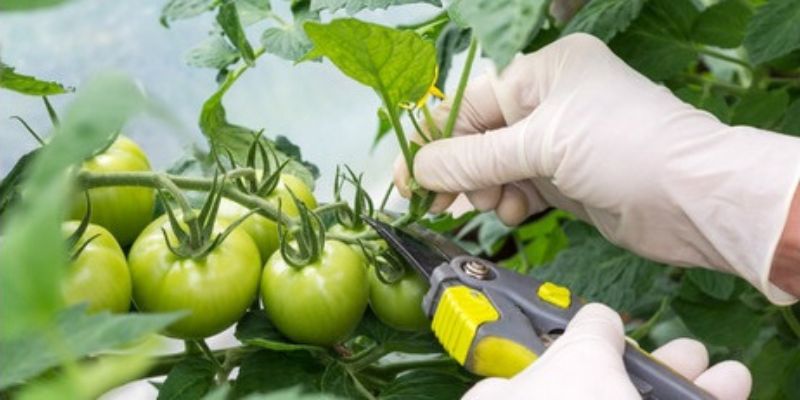Pruning is essential for growing robust, prolific rose bushes, but it can seem intimidating to new gardeners. Without proper pruning, roses become a tangled mess of unruly canes that produce inferior blooms. By learning the best way to prune roses, you can rejuvenate plants and enjoy showstopping flowers.
In this comprehensive guide, you’ll master expert rose pruning techniques. With over 20 years as a horticulturist and avid rose gardener, I’ll share critical tips on tools, timing, methods, and care for incredible results. Follow these best practices for pruning different rose types and taming neglected bushes. With the knowledge of how and when to cut back roses properly, you’ll easily turn your rose garden into a floral showcase.
Introduction to Pruning Roses
Pruning stimulates new growth from the base or lateral buds closest to each cut. Targeted removal of specific canes directs plants’ energy into producing abundant blooms on strong stems. Good pruning practices also open up bushes to light and air circulation, preventing fungal diseases. Proper technique and timing are key – incorrect pruning at the wrong time stresses plants. This guide will cover everything from essential tools to techniques for different rose types so you can get the most out of your roses.
Best Tools for Pruning Roses
Having sharp, clean tools is critical for healthy pruning. Always disinfect tools before and after use. Here are some essentials:
Bypass Pruners
Make clean cuts on stems up to 1⁄4 inch diameter. Long handles provide leverage.
Loppers
Cut thicker canes up to 1⁄2 inch diameter. Look for long handles for extended reach.
Hedge Shears
Quickly trim small shoots and shape bushes. Get swivel blades for versatility.
Garden Saw
For old, thick wood that pruners can’t cut. Curved blades are easier to maneuver.
Disinfectant
Use diluted alcohol or bleach solution to sterilize tools between plants to prevent disease spread.
High-quality tools make pruning easier and help bushes heal faster. Now let’s review when to prune.
Best Time to Prune Rose Bushes
Proper timing is crucial for healthy rose bushes and maximum flowers. Here are the optimal windows:
Winter Pruning
The dormant season is ideal for major corrective pruning and reshaping. Make cuts just before new growth emerges.
Spring Pruning
Remove dead or damaged canes anytime during early spring. Prune lightly to shape bushes and improve air circulation.
Summer Pruning
Mainly remove spent blooms and shape plants lightly during summer. Avoid heavy pruning that stresses plants during hot weather.
Fall Pruning
You can perform light maintenance pruning after the last blooms fade in autumn. Leave major reshaping for winter.
While timing depends on your specific goals, pruning during dormancy is ideal for revitalizing neglected roses. Now let’s review techniques.
Best Way to Prune Roses
In addition to proper timing, using the right techniques keeps roses healthy and productive. Follow these tips:
1. Cut 1⁄4 Inch Above Outward-Facing Buds
Make angled cuts above healthy buds that will grow away from the plant center to shape it.
2. Remove Weak, Damaged, and Crossing Canes
Eliminate tangled branches, dead wood, and diseased or damaged stems to direct energy into strong canes.
3. Thin Dense Center Growth
Cut some old inner canes at ground level to allow light and air penetration.
4. Shape with Desirable Outward Growth
Retain younger, flexible canes with the best outward orientation for maximum blooms.
5. Seal Major Cuts with Paste
Applying sealant after major winter cuts helps prevent dieback from dehydration and disease.
Best Way to Prune Different Rose Types
While techniques stay consistent, pruning severity varies by rose class. Follow these tips:
Large-Flowered Hybrid Teas and Grandifloras
Prune by 1/3 to 1/2 of the plant’s height, shaping with 3-5 healthy main canes.
Old Garden Roses
Take 1/3 off the top and remove old wood. Be conservative to retain their twiggy character.
Climbing Roses
Trim just 1/4 of new growth to shape. Remove excess older canes at the base.
Shrub and Landscape Roses
Lightly shape by thinning up to 1/3 of oldest, tallest stems back to healthy buds.
Tree Roses
Tidy growth above the graft union. Prune the upper portion based on the bush type.
Tailor your approach based on a rose’s specific growth habit for best results. Next, let’s go over training young roses.
How to Prune Young Rose Bushes
Establishing proper structure early via pruning leads to healthy, vigorous roses. Here are tips for young bushes:
1. Select 3-5 Main Canes
Choose widely spaced canes growing outward from the center to become scaffold branches.
2. Remove Competing Stems
Cut off inward-growing shoots and weak growth around main canes.
3. Cut Back Tips
Head back tips of main canes by 1/3 to 1/2 once they reach desired height to encourage bushiness.
4. Eliminate Flower Clusters
Snip off all flower buds on the first shoots to direct energy into root and canopy growth.
5. Fertilize After Pruning
Applying balanced fertilizer following spring pruning feeds plant growth.
Train young rose bushes with regular pruning to build an ideal framework of canes and open shape early on.
How to Rejuvenate Overgrown Rose Bushes
Neglected roses often become a tangled mess of old wood with few blooms. Here are tips for complete rejuvenation:
Start in Winter
Begin major renewal pruning when the bush is dormant to minimize stress.
Remove All Dead and Damaged Wood
Cut out any diseased, injured, or dead stems down to the base to improve plant health.
Cut All Remaining Canes by 1/2 to 2/3
Making significant but selective cuts stimulates abundant new growth from the roots up.
Remove Excess Inner Canes
Thin congested areas to allow light and air penetration to avoid disease.
Fertilize and Water After Pruning
Helping the plant recover with ample nutrition and moisture enables strong regrowth.
Be Patient!
It may take until the second year after rejuvenation pruning to see blooms while the plant recovers. But the renewed vigor will be worth it!
For severely overgrown bushes, be bold when pruning to bring them back to life. Now let’s cover maintenance.
Best Rose Pruning Schedule for Maintenance
To keep rose bushes healthy and productive, prune on this annual schedule:
Winter – Major Pruning
Perform major shaping, thinning, and rejuvenation pruning while plants are dormant.
Spring – Maintenance
Remove dead wood, shape lightly, and improve air circulation when new growth starts.
Summer – Grooming
Mainly snip off spent blooms. Do light pruning only to avoid heat stress.
Fall – Last Touches
Make the final shaping cuts after the last blooms fade before winter.
As Needed – Remove Damaged Canes
Cut out diseased or damaged wood anytime to limit disease spread.
Staying on top of pruning makes it easier with less growth to remove each season.
Conclusion
Learning the best way to prune roses properly is crucial for growing robust, flowering plants. Follow this guide’s expert tips on techniques, tools, timing, and care for incredible results. With a pruned rose bush, you’ll enjoy showstopping sprays of vibrant blooms year after year.

Michael Glenn is a certified arborist and horticultural expert with over 15 years of experience in the landscape industry. His passion for plants and trees has led him to become a sought-after authority on pruning and trimming techniques. Glenn’s in-depth knowledge of proper pruning methods, timing, and tools has helped countless homeowners and professionals maintain healthy, aesthetically pleasing gardens and landscapes.
In addition to sharing his pruning expertise through practical tips, step-by-step guides, and expert advice, Glenn is also a respected author of pruning tool buying guides. His comprehensive reviews and comparisons ensure readers can make informed decisions when investing in quality loppers, pruning shears, saws, and other essential equipment. With a deep understanding of plant biology and sustainable practices, Glenn’s writing empowers audiences with the knowledge needed to properly care for green spaces.





